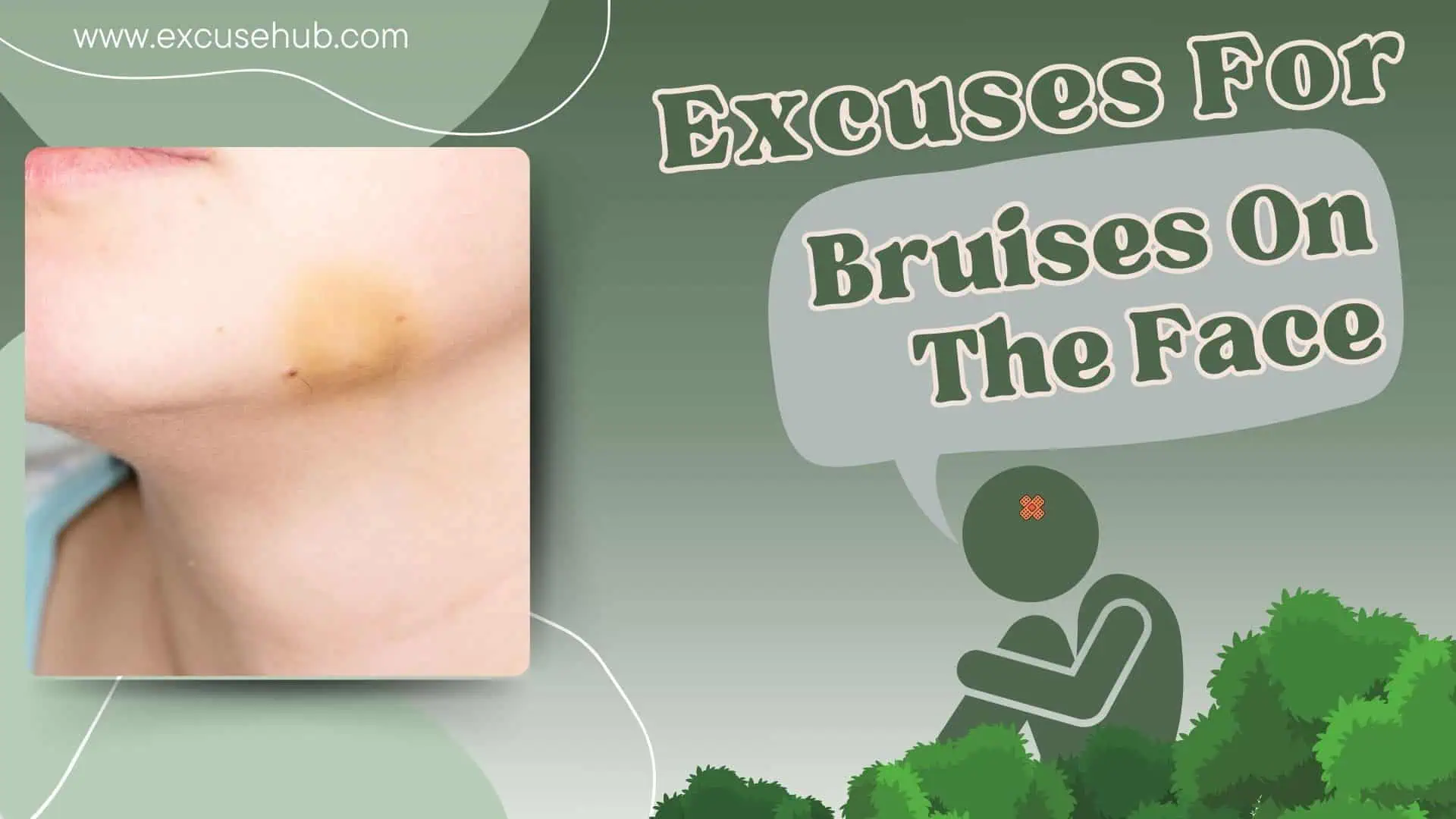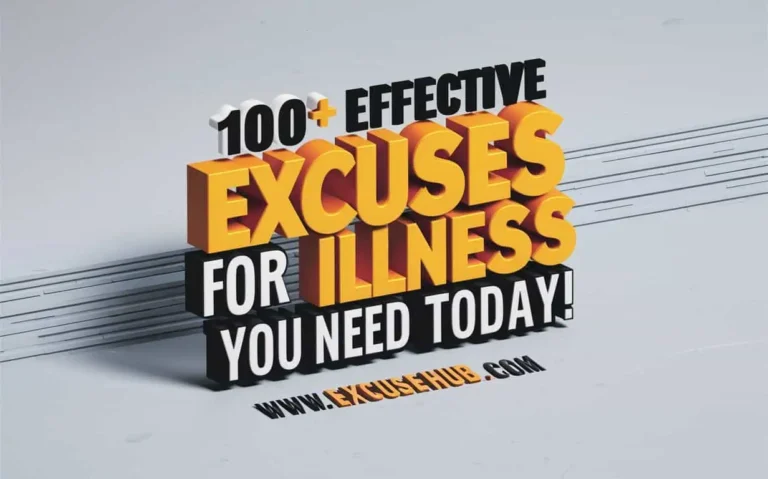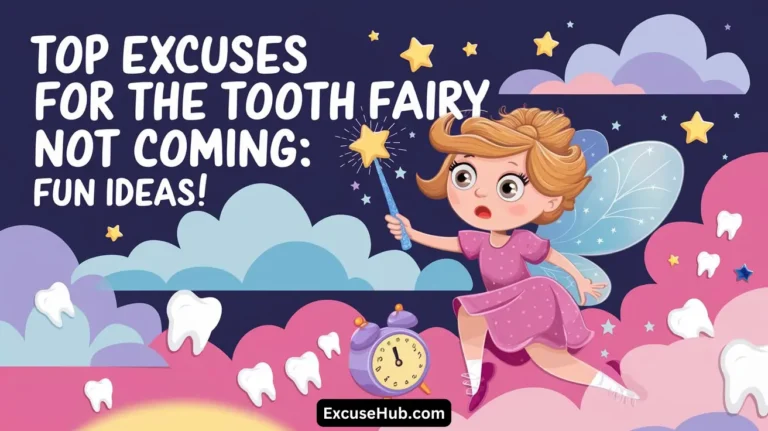Best Excuses for Bruises on Face to Avoid Awkward Questions
Sometimes, a bruise on your face can spark unwanted curiosity. Whether it’s from an innocent mishap or a clumsy moment you’d rather not elaborate on, having a clever excuse ready can save you from those awkward conversations. Here are some relatable Excuses for Bruises on Face and examples to help you! ????
1️⃣ The Classic Accident
Excuse: “I walked into something by mistake.”
Example: “I was distracted on my phone and walked straight into a doorframe!” ????
2️⃣ The Pet Encounter
Excuse: “My pet got a little too playful.”
Example: “My dog jumped up to greet me and accidentally headbutted my face!” ????
3️⃣ The Clumsy Moment
Excuse: “I tripped or fell.”
Example: “I tripped on the carpet and landed face-first into the coffee table!” ????♂️
4️⃣ The Sporting Mishap
Excuse: “I got hit while playing sports.”
Example: “We were playing catch, and the ball came straight for my face!” ????
5️⃣ The Home Hazard
Excuse: “I had a minor accident while cleaning or redecorating.”
Example: “I was cleaning the top shelf and the broom handle fell on me!” ????
6️⃣ The Toddler Tackle
Excuse: “My kid was a bit too energetic.”
Example: “My toddler was dancing on the bed and kicked me while I was lying there!” ????
7️⃣ The Dream Drama
Excuse: “I had a rough night while sleeping.”
Example: “I fell out of bed during a weird dream about fighting ninjas!” ????
8️⃣ The Tech Tragedy
Excuse: “Virtual reality isn’t always safe.”
Example: “I was boxing in VR and punched the wall instead of the opponent!” ????
9️⃣ The Animal Ambush
Excuse: “An animal got the best of me.”
Example: “I tried to trim my cat’s nails, and she didn’t appreciate the gesture!” ????
???? The Unexpected Impact
Excuse: “An object fell on me.”
Example: “I opened the cabinet, and a heavy book fell right onto my face!” ????
Pro Tip: Keep these excuses in your back pocket — you never know when life might surprise you with a face bruise! ????
Good Excuses for Bruises on Face That Sound Totally Believable

Sometimes, life throws unexpected surprises our way — including mysterious bruises that invite unwanted curiosity. If you’ve found yourself with a bruise on your face and need a plausible explanation, you’re not alone. You can always rely on some excuses to use someone’s phone here to help you out in tricky situations.
Whether it’s from a minor mishap or a funny accident, having a convincing excuse ready can save you from awkward conversations. Here are some creative, believable, and unique excuses to help you out — along with relatable examples! ????
1️⃣ The Misjudged High-Five
Excuse: “I got a little too enthusiastic during a high-five.”
Example: “We went for a celebratory high-five, missed entirely, and I smacked myself in the face instead!” ✋
2️⃣ The Rebel Zipper
Excuse: “My jacket betrayed me.”
Example: “I was zipping up my jacket too fast, and the zipper handle swung up and caught me right in the face!” ????
3️⃣ The Door Handle Disaster
Excuse: “I had a run-in with a stubborn door handle.”
Example: “I turned too quickly in the hallway, and the door handle smacked me right in the cheek!” ????
4️⃣ The Selfie Stick Slip-Up
Excuse: “I had a selfie-stick mishap.”
Example: “I was adjusting the angle for a group photo, and the selfie stick collapsed and hit me square in the face!” ????
5️⃣ The Rogue Umbrella
Excuse: “My umbrella turned against me.”
Example: “The wind caught my umbrella, it flipped inside out, and the handle whacked me in the face!” ☔
6️⃣ The Sneaky Cabinet Attack
Excuse: “A cabinet caught me off guard.”
Example: “I opened the kitchen cabinet, and a rogue spice jar fell and clocked me on the cheek!” ????
7️⃣ The Enthusiastic Toothbrush
Excuse: “I got a little too aggressive while brushing my teeth.”
Example: “I was brushing in a rush, slipped, and jabbed myself with the toothbrush handle!” ????
8️⃣ The VR Gaming Glitch
Excuse: “Virtual reality isn’t always safe.”
Example: “I was boxing in VR and accidentally punched the wall instead of the opponent!” ????
9️⃣ The Runaway Laundry Basket
Excuse: “Laundry day turned dangerous.”
Example: “I was carrying the laundry basket down the stairs, tripped, and hit my face on the railing!” ????
???? The Overenthusiastic Dance Move
Excuse: “My dance moves got the best of me.”
Example: “I was practicing a spin, lost my balance, and hit the corner of the coffee table!” ????
Pro Tip: The best excuses come with a confident delivery and a touch of humor — so wear that bruise with pride and share your story with a smile! ????
Unique List of Excuses for Having Bruises on the Face

Bruises on your face can be awkward, but having a quick, believable excuse ready can save you from those uncomfortable stares and questions. Whether it’s from a clumsy accident, an unexpected mishap, or just plain bad luck, here’s a detailed list of creative and unique excuses that sound totally believable.
Feel free to use these as your go-to responses when you’re asked about that mysterious bruise! ???? If you ever need a reason for deleting messages, check out some clever excuses here.
1️⃣ The Rogue Cupboard Incident
Excuse: “I was reaching for something in the cupboard and misjudged the space.”
Detail: “I was trying to grab a can of soup from the top shelf, and when I stretched too far, I knocked into the edge of the cupboard. The corner of the door hit me right on the cheek!”
Why It’s Believable: Everyone has had a moment when they’ve reached for something and bumped into a sharp edge or corner.
2️⃣ The Out-of-Control Sports Ball
Excuse: “I got hit by a ball during a game.”
Detail: “We were playing soccer in the park, and someone kicked the ball a little too hard. It came flying at me, and I didn’t have time to move — straight into the face!”
Why It’s Believable: A stray ball is a common cause of injury in sports and is easy to relate to.
3️⃣ The Clumsy Haircut Disaster
Excuse: “I was getting my haircut, and the stylist accidentally hit me.”
Detail: “I was at the salon when the stylist was using the clippers, and they slipped right into my face. It left a small bruise, but it wasn’t a big deal.”
Why It’s Believable: Haircuts often involve sharp tools, and a small mishap can cause a bruise, especially near the face.
4️⃣ The Pet’s Overenthusiastic Greeting
Excuse: “My dog was a little too excited to see me.”
Detail: “I came home after a long day, and my dog was so happy to see me that he jumped up and bumped his head right into my face!”
Why It’s Believable: Most pet owners know how enthusiastic animals can be when greeting their owners, and it’s easy for pets to cause accidental bumps or bruises.
5️⃣ The Clumsy Phone Drop
Excuse: “My phone slipped out of my hand and hit me in the face.”
Detail: “I was scrolling on my phone, and it slipped from my hand. In a split second, it hit me on the nose before I could catch it.”
Why It’s Believable: Everyone has had their phone slip from their hand at some point, and it’s easy to imagine it hitting you in the face.
6️⃣ The Awkward Fall While Grocery Shopping
Excuse: “I tripped in the store while picking something off the shelf.”
Detail: “I was reaching for a can on the top shelf, lost my balance, and fell forward, grazing my cheek against the corner of a nearby shelf.”
Why It’s Believable: Grocery store trips often lead to small accidents, especially when you’re reaching for something or juggling multiple items.
7️⃣ The Door Frame Collision
Excuse: “I ran into a door frame by accident.”
Detail: “I was rushing out of the room, and didn’t pay attention to the door frame. I ended up hitting my face on the corner!”
Why It’s Believable: Door frame accidents happen frequently, especially when you’re in a hurry.
8️⃣ The Wild Umbrella Incident
Excuse: “My umbrella flipped and hit me in the face.”
Detail: “I was walking in the wind when the umbrella flipped inside out, and the metal frame hit me right in the eye.”
Why It’s Believable: Umbrellas can be tricky in strong winds, and their metal frames can easily cause bruises.
9️⃣ The Unfortunate Gym Equipment Malfunction
Excuse: “I got a little too close to the gym equipment.”
Detail: “I was working out at the gym, doing some squats, and the barbell slipped a little. When I moved, I accidentally bumped into one of the nearby machines, which gave me a nasty bruise.”
Why It’s Believable: Gym equipment can be dangerous if not handled properly, and it’s easy to imagine a misstep resulting in a bruise.
???? The Surprise Falling Object
Excuse: “A heavy object fell off the shelf and hit me.”
Detail: “I was just standing there when a book from the top shelf fell and hit me on the face.”
Why It’s Believable: Accidents like falling books or items from shelves are common, and it’s plausible that it could cause a bruise.
1️⃣1️⃣ The Runaway Bike Incident
Excuse: “I fell off my bike.”
Detail: “I was riding my bike when I lost my balance and fell face-first onto the ground. The bruise is from the fall.”
Why It’s Believable: Biking accidents are a common cause of bruises, especially for those who are still learning or riding in rough areas.
1️⃣2️⃣ The Unexpected Tumble While Running Late
Excuse: “I was rushing and tripped.”
Detail: “I was running to catch the bus, and I tripped over a curb. I landed face-first on the sidewalk!”
Why It’s Believable: Everyone’s had a moment where they were running late and tripped, making this excuse sound very relatable.
Pro Tip: The key to making these excuses believable is to remain calm and casual. A little humor mixed in will make the explanation even more convincing, so don’t be afraid to laugh it off!
Hilarious & Honest Excuses for Bruises You Won’t Believe!

Bruises happen, but sometimes explaining them can be a real challenge, especially when you want to avoid the awkward stares or endless questions. Whether you’ve had a little accident or want to keep things lighthearted, here are 5 hilarious and honest excuses that’ll have everyone laughing — or at least stop them from asking too many questions! ???? Need a good excuse for a busted lip? You can check out some creative excuses here.
1️⃣ The Overenthusiastic Pet
Excuse: “My dog got a little too excited and jumped right into me!”
Detail: “I was just coming through the door, and my dog was so happy to see me that he bumped me in the face with his head. This bruise is just his way of saying ‘hello’!”
2️⃣ The Clumsy Kitchen Mishap
Excuse: “I was making dinner and the cabinet door hit me.”
Detail: “I reached for a pan, and the cabinet door swung back into my face. I guess I wasn’t paying enough attention!”
3️⃣ The Out-Of-Control Sports Ball
Excuse: “I got hit by a flying ball during a soccer game.”
Detail: “We were playing in the park, and someone kicked the ball too hard. It came at me like a missile!”
4️⃣ The DIY Disaster
Excuse: “I was doing a DIY project, and something went wrong.”
Detail: “I was hammering a nail, and the hammer slipped — right into my cheek! Lesson learned: leave the DIY to the professionals.”
5️⃣ The Door Frame Face-Off
Excuse: “I wasn’t paying attention and ran right into a door frame.”
Detail: “I was in a hurry, trying to grab something, and bam! I walked straight into the door frame. Now I’m paying the price!”
These excuses are sure to make light of the situation and give you the perfect story for anyone who asks about your bruise!
Creative Cover Stories for Facial Bruises

Sometimes a bruise on your face needs a bit of creativity to explain—whether you’re trying to avoid the embarrassment or just want to add some humor to the situation. Here are some unique and creative cover stories that will leave people chuckling or scratching their heads, while giving you the perfect excuse for that unexplainable bruise! ???? If you’re also looking for good excuses to miss school, you can find some helpful ones here.
1️⃣ The “Artistic” Sculptor
Story: “I’m trying out this new art form where you carve sculptures with your face.”
Why it works: The more dramatic, the better! This will confuse anyone who dares ask about your bruise and keep the conversation lighthearted.
2️⃣ The Overzealous Yoga Pose
Story: “I was doing yoga and ended up face-planting during the ‘downward dog’ pose.”
Why it works: Who knew yoga could be dangerous? If you’re into fitness, this story sounds believable and a little ridiculous at the same time.
3️⃣ The Wild Adventure
Story: “I was trekking through the jungle on my latest adventure, and I tripped over a vine.”
Why it works: A bit of wilderness and a touch of adventure can spice up any bruise. This is the kind of story that’ll keep people intrigued!
4️⃣ The Friendly Combat Sports
Story: “I started taking up boxing, and my sparring partner got a little too enthusiastic!”
Why it works: Boxing sounds intense, and this cover story gives you a tough-guy vibe while subtly explaining your face injury.
5️⃣ The ‘Mysterious’ Superhero Incident
Story: “I was out saving the world, and a villain threw something at me.”
Why it works: Channel your inner superhero! It’s quirky and just vague enough to leave people guessing if you’re joking or serious.
6️⃣ The Dramatic Haunted House
Story: “I went through a haunted house, and one of the props got me good!”
Why it works: You can blame it on spooky thrills. This is the perfect story for a bruise you got while trying to have a little fun.
7️⃣ The ‘Clumsy Me’ Confession
Story: “I tripped on a rug and had a hilarious tumble—this is just the aftermath.”
Why it works: Keeping it simple, and a little self-deprecating, is often the easiest way to keep things casual and avoid further questioning.
8️⃣ The Dramatic ‘Sibling’ Rivalry
Story: “My sibling and I got into an epic pillow fight. I might have taken it a little too seriously.”
Why it works: Sibling rivalries are always an easy way to explain a face bruise. Just make it sound like part of an intense family battle!
9️⃣ The Surprising Low-Flying Bird
Story: “I was walking outside and a bird flew straight into my face. Worst timing ever!”
Why it works: Bird collisions are rare but memorable! If you’re quick with your delivery, people will probably laugh instead of question the truthfulness.
???? The Accident-Prone Storyteller
Story: “I’m just a magnet for accidents. This time, I slipped while trying to pick something up off the floor!”
Why it works: Sometimes keeping it honest and embracing the clumsy side works best! This excuse is relatable and gives you an instant out.
These creative cover stories are sure to get you through any awkward moment involving a facial bruise, while leaving people amused or perplexed!
How People Get Bruised

Bruises happen to just about everyone, whether it’s from a minor accident or a more dramatic incident. Here’s a look at the most common ways people end up with those unsightly marks:
1️⃣ Accidental Bumps and Scrapes
How It Happens: One of the most common causes of bruises is simply bumping into furniture, walls, or even other people. A quick stumble or a misstep while walking can result in an unintentional collision with something hard, causing a bruise.
2️⃣ Clumsiness
How It Happens: Whether it’s tripping over your own feet or knocking into something unexpectedly, clumsiness is a major culprit behind many facial bruises. You’re not alone if you’ve walked into a doorframe or had a minor fall!
3️⃣ Sports Injuries
How It Happens: Contact sports like soccer, basketball, or even martial arts can lead to bruises. Whether it’s a kick, a tackle, or a rough landing, these activities can easily cause bruising, especially on the face if you’re in the heat of the game.
4️⃣ Accidental Falls
How It Happens: Slipping on a wet surface, tripping over uneven pavement, or simply losing your balance can lead to a fall. A fall can easily cause bruises on the face, especially if you land on something hard like the edge of a table or the floor.
5️⃣ Injuries from Objects
How It Happens: A flying object, such as a ball, a dropped item, or even a pet’s enthusiastic leap, can easily strike the face and leave a bruise. These sudden, unexpected impacts can create a visible mark, particularly around the eyes or cheeks.
6️⃣ Accident-Prone Pets
How It Happens: Pets are a source of joy, but they can also cause some unintentional bruising. Whether it’s a dog jumping up to greet you or a cat darting around your legs, you might end up with a bruise after a sudden encounter.
7️⃣ DIY and Household Mishaps
How It Happens: Engaging in home improvement projects, gardening, or even cleaning can result in bruises. Hitting your head on an open cabinet, slipping while handling tools, or accidentally banging into furniture are all common ways people bruise themselves during everyday tasks.
8️⃣ Viral Infections or Medications
How It Happens: Certain medications, such as blood thinners or steroids, can make your skin more prone to bruising. Additionally, some viral infections can weaken the blood vessels, making you more susceptible to bruising, even from minor incidents.
9️⃣ Fighting or Physical Confrontations
How It Happens: Physical altercations, whether in self-defense or an argument that escalates, can often result in bruising. A punch, slap, or even being shoved can leave a visible bruise on the face or body.
???? Allergic Reactions or Injections
How It Happens: Sometimes, allergic reactions to certain substances or injections like vaccines can cause the skin to react with bruising. This is usually a result of the skin or underlying tissues reacting to an irritant or needle.
Bruises can occur in all sorts of ways, from the most mundane to the more dramatic, and they’re usually harmless. However, they do make for interesting stories, and often people end up finding unique excuses for them!
Turning Accidents into Believable Excuses
Accidents happen, and knowing how to transform these unexpected events into believable excuses can save you from uncomfortable questions about your facial bruises. When crafting creative excuses, it’s crucial to take into account the plausibility and context of your story. Here are four strategies to create believable excuses for bruises:
- Draw from Actual Activities: If you’re regularly engaged in physical activities or sports, citing these as the source of your bruises lends credibility. For instance, ‘I got this while playing soccer’ is a straightforward, believable excuse.
- Leverage Common Household Accidents: Many people can relate to the mishaps of daily life. Saying, ‘I walked into a door’ or ‘I slipped in the shower’ are common and, therefore, believable excuses.
- Incorporate Work-Related Scenarios: If your job involves physical labor or the potential for accidents, mentioning work as the cause can be effective. ‘I had a small accident with some equipment at work’ is both specific and plausible.
- Use Humor Sparingly: While humor can ease the tension, make sure it’s appropriate and doesn’t undermine the believability of your excuse. A light-hearted comment like, ‘You should see the other guy,’ can work if it fits the scenario and your personality.
Conclusion
In sum, whether your facial bruises stem from mundane mishaps or unforeseen accidents, remember that the healing journey mirrors the body’s remarkable capacity for repair and resilience.
Isn’t it fascinating how we can spin tales, blending truth with creativity, to navigate social inquiries?
As you embrace these strategies, let them not only serve as shields but also as reminders of our shared vulnerability and the intricate stories etched onto the canvas of our skin.








2 Comments